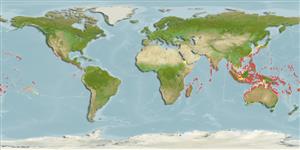>
Anguilliformes (Eels and morays) >
Ophichthidae (Snake eels) > Ophichthinae
Etymology: Brachysomophis: Greek, brachys, eia = short + Greek, soma = body + Greek, ophis = serpent (Ref. 45335); crocodilinus: crocodilinus in reference to its appearance (Ref. 42180).
More on author: Bennett.
Environment: milieu / climate zone / depth range / distribution range
Ekologi
laut berasosiasi dengan karang; kisaran kedalaman 0 - 30 m (Ref. 42180), usually 0 - 2 m (Ref. 42180). Tropical
Indo-Pacific: East Africa in Tanzania, Seychelles and Mauritius (Ref. 3972), to the Society Islands (but not the Hawaiian Archipelago), north to Japan, south to Australia (Ref. 33390).
Size / Weight / umur
Maturity: Lm ? range ? - ? cm
Max length : 120 cm TL jantan/; (Ref. 9710)
vertebrata, bertulang belakang: 116 - 124. Diagnosis: Dorsal fin arising well behind pectoral tips; pectoral fins teardrop-shaped; snout very short; jaws elongate; anterior nostril in a very short tube in upper lip, closely followed by an ethmoidal pore, a barbel, and the posterior nostril which is in outer lip and entirely covered by a flap; labial cirri numerous, unbranched and slender in anterior half of lip of mandible, those posterior and along lower lip branched at tips; flesh above and behind eye laterally elevated as a ridge; dorsal head profile notably incised and medially constricted behind eyes, the flesh forming a narrow transverse ridge behind dorsal margin of eyes; head pores and lateral-line pores apparent; free sensory neuromasts visible as rows of small white spots on nape; teeth conical (Ref. 42180). Lateral-line pores and temporal pores typically in dark spots; smaller dark spots present irregularly on flank between lateral line and dorsal fin of larger specimens (Ref. 42180). Eye small, coloured like the head, and placed towards the front of the long mouth (Ref. 48635).
Generally found in shallow lagoon sand, rock and broken coral substrates at depths of 0-2 m (Ref. 42180). Benthic (Ref. 58302), occurs in sandy bottoms from intertidal to over 12 m.; remains buried in sand with only the eyes protruding where it waits to ambush fish (Ref. 9710) and octopuses (Ref. 275). Used in Chinese medicine (Ref. 12166).
Life cycle and mating behavior
Kematangan | Reproduksi, perkembang biakan | Pemijahan | telur-telur | Fecundity | Larva
McCosker, J.E. and J.E. Randall, 2001. Revision of the snake-eel genus Brachysomophis (Anguilliformes: Ophichthidae), with description of two new species and comments on the species of Mystriophis. Indo-Pac. Fish. (33):1-32. (Ref. 42180)
Status IUCN Red List (Ref. 130435: Version 2024-1)
ancaman kepada manusia
Harmless
penggunaan manusia
Alat, peralatan
laporan khas
muat turun XML
Sumber internet
Estimates based on models
Preferred temperature (Ref.
123201): 24.7 - 29.3, mean 28.3 °C (based on 2746 cells).
Phylogenetic diversity index (Ref.
82804): PD
50 = 0.5078 [Uniqueness, from 0.5 = low to 2.0 = high].
Bayesian length-weight: a=0.00091 (0.00039 - 0.00215), b=2.99 (2.79 - 3.19), in cm total length, based on LWR estimates for this (Sub)family-body shape (Ref.
93245).
Trophic level (Ref.
69278): 4.1 ±0.58 se; based on food items.
Daya lenting (Ref.
120179): sedang, Waktu penggandaan populasi minimum 1.4 - 4.4 tahun (Preliminary K or Fecundity.).
Fishing Vulnerability (Ref.
59153): High to very high vulnerability (72 of 100).
Nutrients (Ref.
124155): Calcium = 27.8 [14.5, 50.8] mg/100g; Iron = 0.436 [0.258, 0.977] mg/100g; Protein = 19 [17, 22] %; Omega3 = 0.0994 [, ] g/100g; Selenium = 42.9 [23.9, 87.3] μg/100g; VitaminA = 46.6 [14.5, 139.1] μg/100g; Zinc = 0.787 [0.562, 1.112] mg/100g (wet weight);
